- Clematis Wilting: Identifying Causes and Effective Solutions
- Possible Causes of Clematis Wilting
- Effective Solutions
- Albizia Wilting: Causes, Symptoms, and Ways to Save Your Tree
- Causes of Albizia Wilting
- Symptoms of Albizia Wilting
- Ways to Save Your Albizia Tree
- Conclusion
- Wisteria Shattering: Understanding the Problem and Finding Solutions
- Causes of Wisteria Shattering:
- Solutions to Prevent Wisteria Shattering:
- Poor Drainage: The Hidden Culprit Behind Clematis Wilting
- How Poor Drainage Affects Clematis
- Signs of Poor Drainage
- Improving Drainage for Clematis
- Conclusion
- Albizia Wilting: The Significance of Fungal Infections
- Types of Fungal Infections
- Symptoms of Fungal Infection
- Preventing and Treating Fungal Infections in Albizia Trees
- Conclusion
- Wisteria Shattering: The Role of Temperature and Humidity
- Temperature
- Humidity
- Preventing Wisteria Shattering
- Clematis Wilting: Overwatering or Underwatering?
- Overwatering
- Underwatering
- Conclusion
- Albizia Wilting: Recognizing and Treating Pest Infestations
- Recognizing Pest Infestations
- Treating Pest Infestations
- Wisteria Shattering: Pruning Techniques for a Healthier Plant
- Causes of Wisteria Shattering
- Pruning Techniques for Preventing Wisteria Shattering
- Clematis Wilting: Ensuring Proper Sunlight and Shade
- 1. Sunlight Requirements
- 2. Shade Requirements
- Questions and Answers:
- Why is my clematis wilting?
- What should I do if my albizzia is wilting?
- Why is my wisteria shattering?
- How often should I water my clematis?
- Can fungal diseases affect my clematis?
- Videos: Keep plants blooming, deadheading clematis.
Clematis, albizia, and wisteria are beautiful flowering plants that add color and charm to any garden. However, they can sometimes face issues like wilting and shattering, which can be quite frustrating for gardeners. Understanding the causes and finding solutions is essential to ensure the health and vitality of these plants.
Wilting is a common problem that can affect clematis and albizia. Wilting occurs when the plants are not receiving enough water or when their roots are damaged. Lack of water can cause the leaves to become droopy and dry, while root damage can prevent the plants from absorbing sufficient moisture. In extreme cases, wilting can lead to the death of the plants.
Shattering is another issue that can impact wisteria. Shattering refers to the sudden dropping of buds or flowers before they have a chance to fully bloom. This can be caused by environmental factors such as extreme temperatures or strong winds, or it can be a sign of poor plant health or nutrient deficiency. Whatever the cause, shattering can be highly disappointing for gardeners who eagerly await the beautiful blossoms of wisteria.
The good news is that there are solutions to these problems. For clematis and albizia, ensuring regular watering is essential. These plants prefer moist soil, so it is important to water them deeply and regularly, especially during periods of dry weather. Additionally, adding a layer of organic mulch around the base of the plants can help retain moisture and protect the roots.
To prevent shattering in wisteria, it is important to provide proper care and maintenance. This includes choosing a sheltered location for the plant, protecting it from strong winds, and providing adequate support for its vines. Regular pruning and fertilizing can also help promote healthy growth and minimize the risk of shattering.
In conclusion, wilting and shattering can be common issues with clematis, albizia, and wisteria. Understanding the causes and implementing appropriate solutions, such as proper watering, mulching, and maintenance, can help ensure the health and longevity of these beautiful flowering plants, allowing gardeners to enjoy their stunning blooms for years to come.
Clematis Wilting: Identifying Causes and Effective Solutions
Clematis plants are known for their striking flowers and beautiful vine-like growth. However, sometimes clematis plants may experience wilting, where the leaves and stems appear droopy and unhealthy. In this article, we will explore the possible causes of clematis wilting and provide some effective solutions to save your plant.
Possible Causes of Clematis Wilting
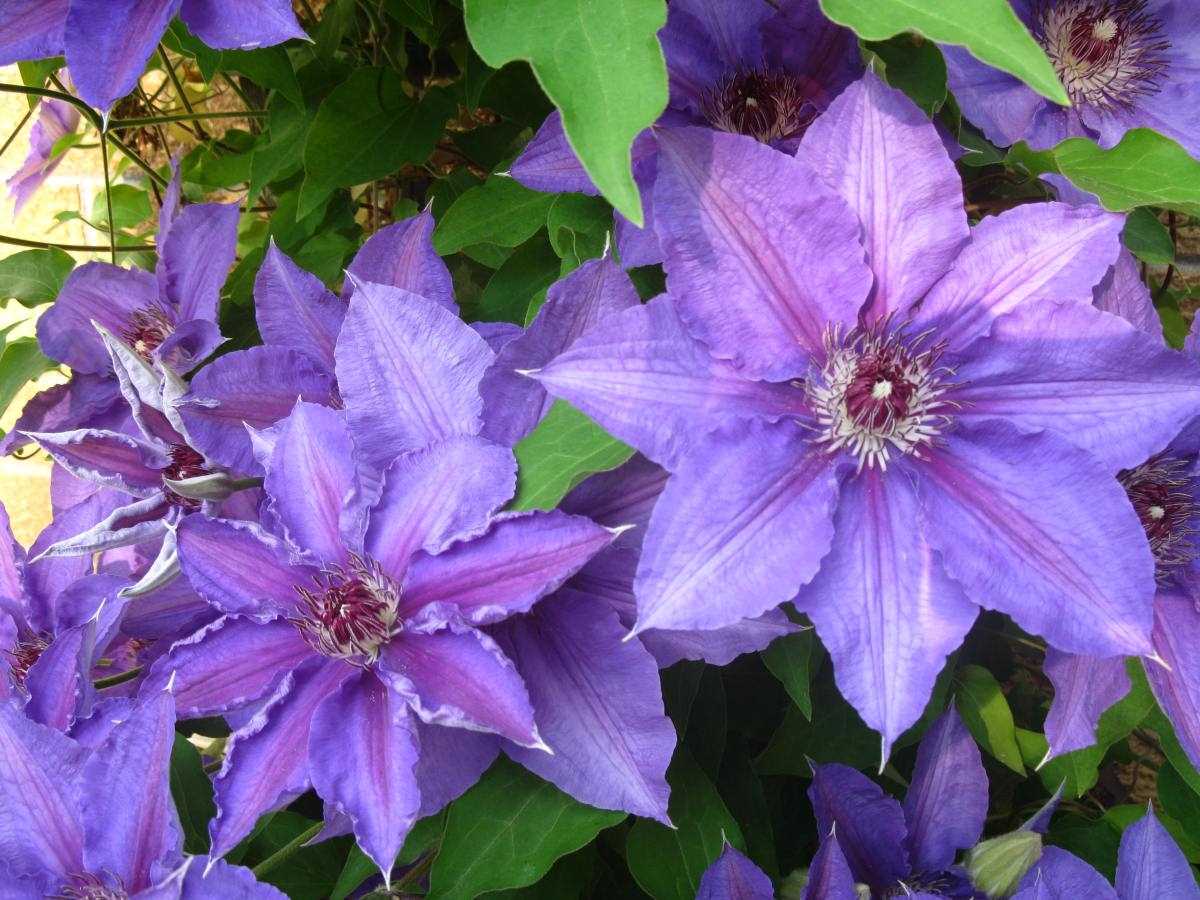
1. Overwatering: Clematis plants prefer well-drained soil, and overwatering can lead to waterlogged roots, which in turn can cause wilting. Make sure to water your clematis plant properly, allowing the soil to dry out slightly between waterings.
2. Underwatering: On the other hand, if your clematis plant is not receiving enough water, it can also result in wilting. Regularly check the soil moisture and increase the frequency of watering during hot and dry periods.
3. Root Rot: Clematis plants are susceptible to root rot caused by fungal pathogens like Phytophthora. Root rot can cause wilting due to the damaged root system. Remove any infected roots and replant your clematis in well-draining soil.
4. Lack of Sunlight: Clematis plants require at least six hours of direct sunlight each day. Insufficient sunlight can weaken the plant, leading to wilting. Ensure that your clematis plant is located in a spot with adequate sunshine.
Effective Solutions
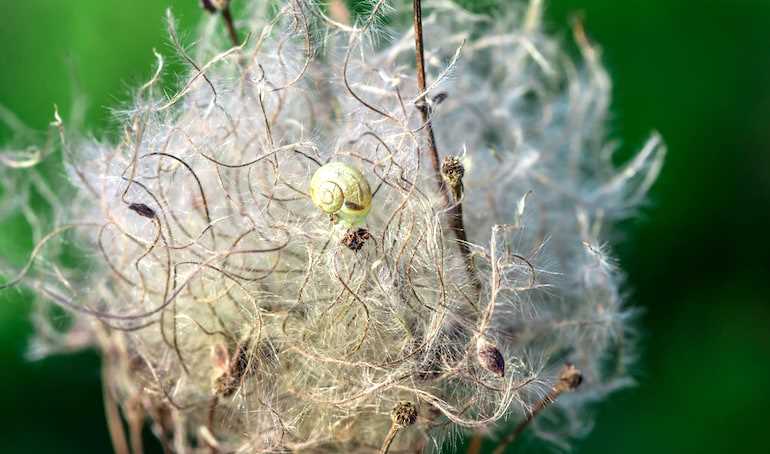
- Check the soil moisture regularly and adjust your watering schedule accordingly.
- Ensure that the soil is well-drained to prevent waterlogging and root rot. Consider adding organic matter or perlite to improve drainage.
- Inspect the roots for signs of rot. If root rot is detected, remove the infected roots and replant the clematis in fresh, well-draining soil.
- Make sure your clematis plant is getting enough sunlight. If necessary, consider transplanting it to a sunnier location.
- Apply a balanced fertilizer specifically formulated for clematis plants to provide necessary nutrients and promote healthy growth.
- Protect your clematis plant from extreme temperatures by providing mulch around the base of the plant.
- Monitor for pests such as aphids or spider mites and take appropriate measures to control them.
By identifying the causes and implementing the appropriate solutions, you can revive your wilting clematis plant and enjoy its vibrant blooms once again.
Albizia Wilting: Causes, Symptoms, and Ways to Save Your Tree
Causes of Albizia Wilting
Albizia wilting, also known as Albizia Tree Disease, is caused by a fungal pathogen called Fusarium solani. The fungal spores enter the tree through wounds or natural openings, such as stomata, and infect the vascular system. This leads to wilting and ultimately the death of the tree if left untreated.
Symptoms of Albizia Wilting
One of the main symptoms of Albizia Wilting is the wilting and yellowing of the tree’s foliage. The leaves may droop and eventually fall off, leaving the tree with a sparse canopy. The vascular system of the tree may also show signs of discoloration, such as brown streaks or dark spots. In severe cases, the entire tree may die.
Ways to Save Your Albizia Tree
- Prune affected branches: Start by pruning any branches that show signs of wilting or discoloration. This will help prevent further spread of the disease.
- Improve tree health: Ensure that your tree is getting proper nutrients, water, and sunlight. A healthy tree is better able to fight off fungal infections.
- Fungicide treatment: Apply a fungicide specifically formulated to treat Fusarium solani infections. Follow the instructions carefully and repeat the treatment as directed.
- Avoid stress: Avoid any additional stress to the tree, such as excessive pruning or drought conditions, as this can weaken the tree and make it more susceptible to fungal infections.
- Remove fallen leaves: Remove any fallen leaves or debris from around the base of the tree, as these can harbor fungal spores.
It’s important to note that the success of saving an Albizia tree from wilting depends on the severity of the infection. In some cases, it may not be possible to save the tree, and it may need to be removed to prevent the spread of the disease to nearby trees.
Conclusion
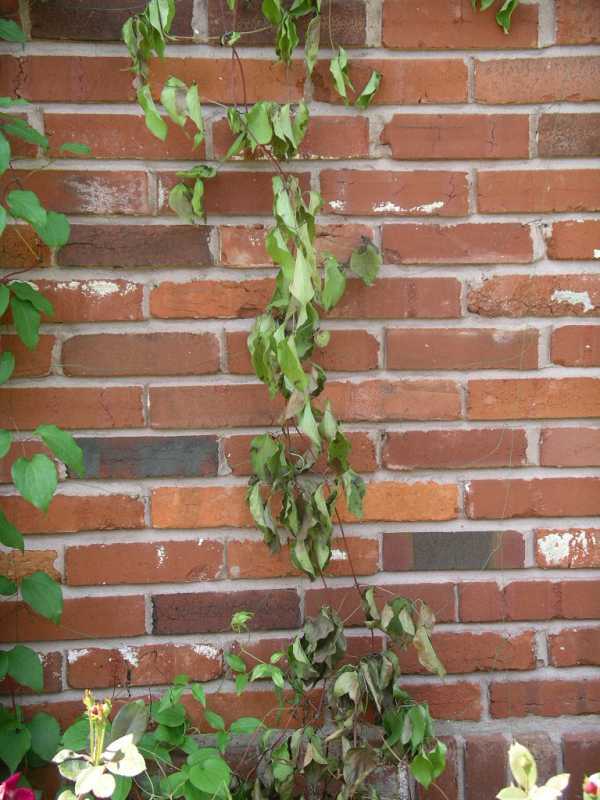
Albizia Wilting is a serious fungal disease that can cause the death of your Albizia tree. If you notice wilting or discoloration in your tree’s foliage, it’s important to take immediate action. Pruning affected branches, improving tree health, and applying fungicide treatments can help save your Albizia tree and prevent further spread of the disease.
Wisteria Shattering: Understanding the Problem and Finding Solutions
Wisteria is a beautiful flowering vine that is known for its cascading clusters of fragrant flowers. However, one common problem that many wisteria gardeners face is the issue of wisteria shattering. This occurs when the flowers of the wisteria vine suddenly drop off before they have a chance to fully bloom.
Causes of Wisteria Shattering:
- Environmental Stress: Wisteria shattering can be a natural response to environmental stressors such as extreme temperatures, drought, or excessive rain.
- Poor Pruning: Improper pruning techniques can damage the flower buds of the wisteria, leading to premature dropping of flowers.
- Inadequate Nutrients: Wisteria plants require sufficient nutrients to support healthy flower development. A lack of nutrients can result in weak or prematurely dropping flowers.
- Pest and Disease Infestation: Certain pests and diseases can cause damage to the flower buds, resulting in shattering before blooming.
Solutions to Prevent Wisteria Shattering:
- Provide Adequate Care: Ensure that your wisteria vine receives proper care and maintenance, including regular watering, fertilization, and protection from extreme weather conditions.
- Prune Correctly: Learn proper pruning techniques for wisteria and prune during appropriate seasons to minimize damage to the flower buds.
- Monitor Nutrient Levels: Test the soil regularly to check for nutrient deficiencies and adjust the fertilizer accordingly to provide the necessary nutrients for healthy flower development.
- Pest and Disease Control: Regularly inspect your wisteria plant for signs of pest or disease infestation and take appropriate measures to control and prevent any damage.
By understanding the causes of wisteria shattering and implementing the appropriate solutions, you can help ensure that your wisteria vine produces beautiful, abundant blooms for you to enjoy.
Poor Drainage: The Hidden Culprit Behind Clematis Wilting
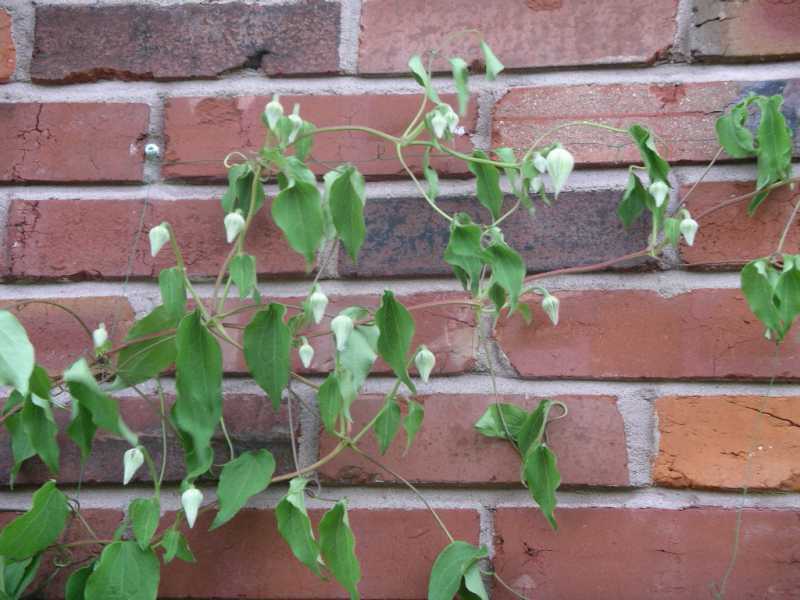
Clematis is a beautiful and popular flowering vine that adds color and charm to any garden. However, sometimes clematis plants can suddenly start wilting and looking unhealthy, making the garden less appealing. One of the reasons behind clematis wilting is poor drainage.
How Poor Drainage Affects Clematis
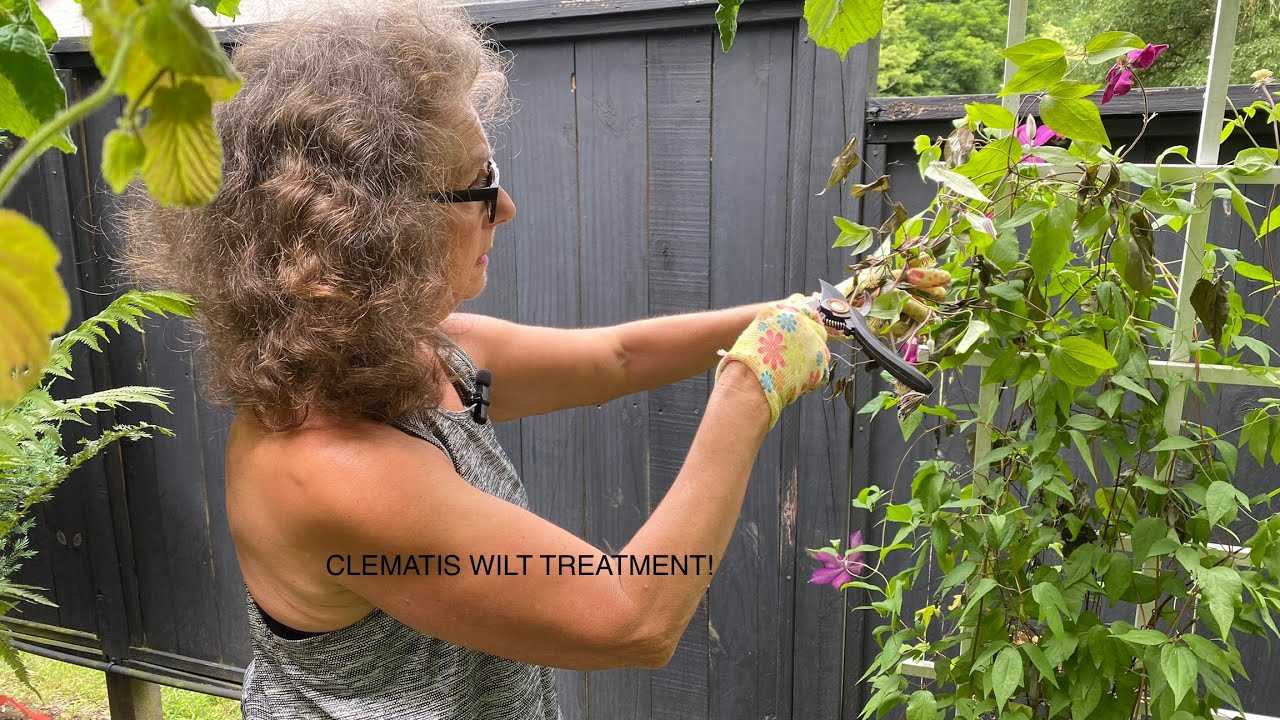
Poor drainage can cause water to accumulate around the roots of the clematis plant, leading to root rot. When the roots are constantly soaked in water, they are unable to access oxygen, which is necessary for their survival. As a result, the roots become weak and can no longer support the plant’s water and nutrient needs, causing the clematis to wilt.
Signs of Poor Drainage
There are a few signs that can indicate poor drainage in the garden:
- Excessively wet soil
- Foul odor coming from the soil
- Yellowing leaves or stunted growth
If you notice any of these signs, it’s likely that your clematis is suffering from poor drainage.
Improving Drainage for Clematis
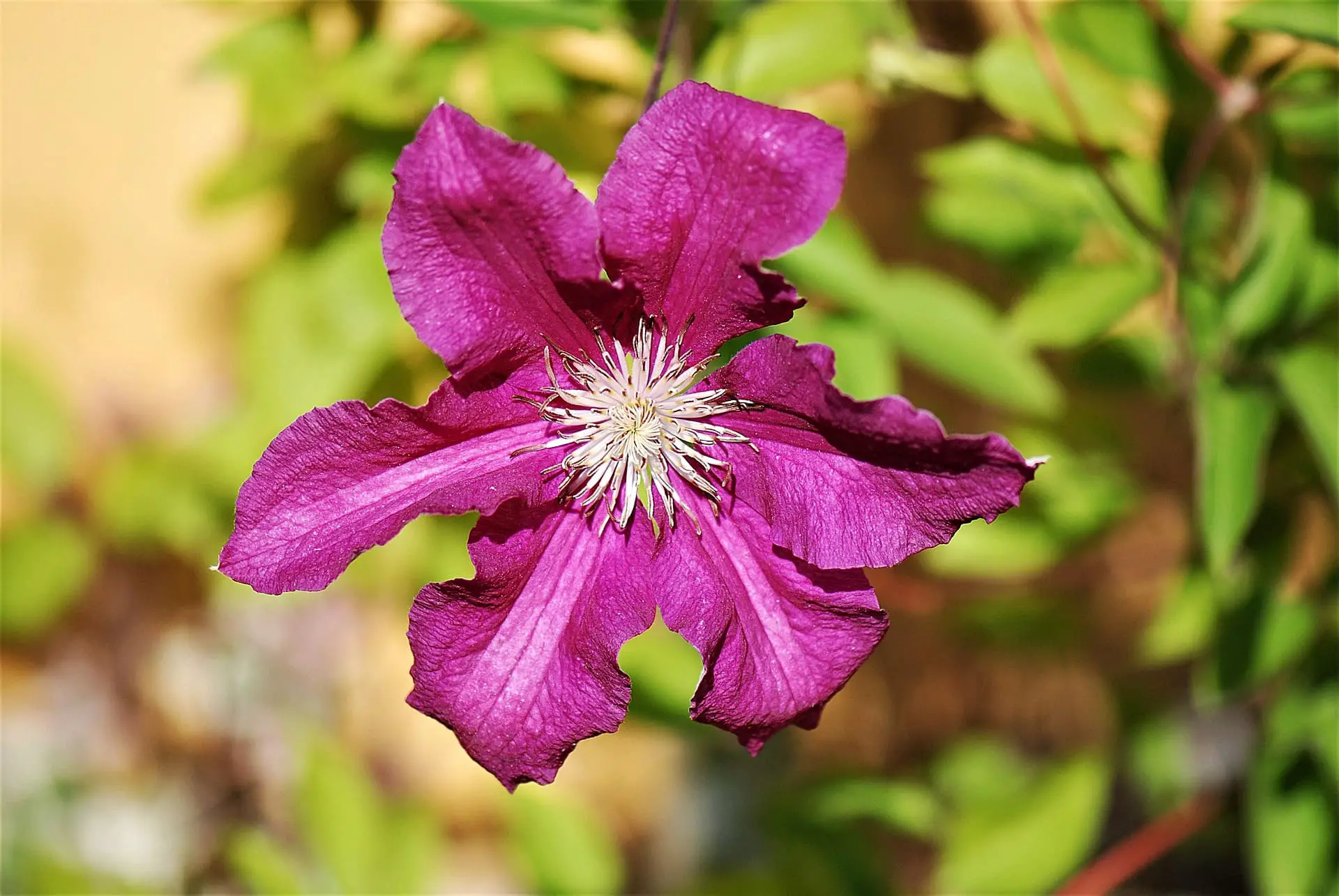
To prevent clematis wilting caused by poor drainage, it’s important to improve the drainage in your garden:
- Choose the right location: Select a site for planting clematis that has well-drained soil and is not prone to waterlogging.
- Amend the soil: If your soil has poor drainage, you can amend it by adding organic matter such as compost or well-rotted manure to improve its structure and drainage capacity.
- Consider raised beds or containers: If your garden soil is consistently wet, planting clematis in raised beds or containers with well-draining soil can help provide better drainage.
- Provide proper water management: Water your clematis plants deeply but infrequently to allow the soil to dry out between watering. Avoid overwatering.
- Use mulch: Mulching around the base of the clematis plant can help keep the soil moisture levels balanced and prevent excessive water retention.
Conclusion
Poor drainage is often the hidden culprit behind clematis wilting. By recognizing the signs of poor drainage and taking steps to improve it, you can help your clematis plants thrive and prevent them from wilting. With proper drainage, you can enjoy the beauty of healthy clematis vines in your garden.
Albizia Wilting: The Significance of Fungal Infections
Albizia wilting is a common problem that affects Albizia trees. One of the main causes of wilting in Albizia trees is fungal infections. Fungal infections can have a significant impact on the health and vigor of Albizia trees, leading to wilting, leaf drop, and even death if left untreated.
Types of Fungal Infections
There are several types of fungal infections that can affect Albizia trees, including:
- Vascular wilt diseases: These fungal infections invade the tree’s vascular system, impairing water and nutrient transport. Fusarium wilt and verticillium wilt are common vascular wilt diseases that can cause Albizia wilting.
- Root rot: Fungal pathogens, such as Phytophthora spp. and Armillaria spp., can infect the roots of Albizia trees, leading to rotting and eventually causing wilting symptoms.
- Leaf spot diseases: While leaf spot diseases may not directly cause wilting, they can weaken the Albizia tree’s overall health and make it more susceptible to other fungal infections that can lead to wilting.
Symptoms of Fungal Infection
When Albizia trees are infected with fungal pathogens, they may display several symptoms, including:
- Wilting: Leaves and branches may start to droop and wilt, eventually leading to defoliation.
- Leaf discoloration: Infected leaves may turn yellow or brown, indicating a lack of vitality.
- Stunted growth: Fungal infections can impede the tree’s ability to grow, leading to reduced overall size and vigor.
Preventing and Treating Fungal Infections in Albizia Trees
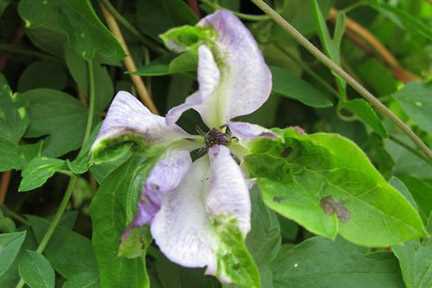
Prevention and early intervention are key to managing fungal infections in Albizia trees. Here are some measures that can help prevent and treat fungal infections:
- Proper tree care: Maintain proper tree hygiene by removing fallen leaves and debris, which can harbor fungal spores. Avoid overwatering or creating conditions of excess moisture, as this can promote fungal growth.
- Fungicide treatments: In cases of severe fungal infections, fungicide treatments may be necessary. Consult with a professional arborist or horticulturist to identify the appropriate fungicide and application method.
- Improving soil drainage: Ensure that the soil around Albizia trees has good drainage to prevent waterlogging, as this can create conditions favorable for fungal growth. Consider aerating compacted soils or adding organic matter to improve drainage.
Conclusion
Fungal infections can have a detrimental effect on the health and vitality of Albizia trees, leading to wilting and other symptoms. By implementing preventive measures and taking prompt action at the first signs of infection, it is possible to mitigate the impact of fungal pathogens and preserve the health of Albizia trees.
Wisteria Shattering: The Role of Temperature and Humidity
Wisteria plants are known for their beautiful cascading flowers, which create a stunning display when in full bloom. However, one common issue that gardeners may face is the phenomenon known as “wisteria shattering.” This is when the flowers or buds of the wisteria plant fall off prematurely, before reaching full bloom. Understanding the causes of wisteria shattering can help gardeners prevent or mitigate this problem.
Temperature
The temperature plays a significant role in the occurrence of wisteria shattering. Extreme heat or cold can cause the flowers or buds to drop. High temperatures can cause stress to the plant, leading to the shedding of flowers. On the other hand, sudden drops in temperature, especially during early spring when wisteria plants are starting to bloom, can also trigger flower drop. It is essential to provide a stable temperature environment for wisteria plants to reduce the risk of shattering.
Humidity
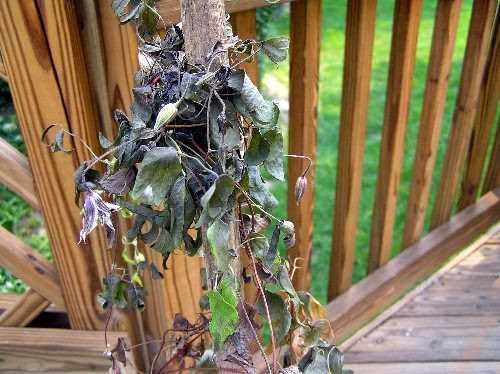
Humidity levels can also influence wisteria shattering. High humidity, coupled with poor airflow, can create a favorable environment for fungal diseases, such as botrytis blight (gray mold). This disease can cause flower buds to rot and drop prematurely. It is crucial to maintain proper humidity levels by ensuring adequate ventilation and avoiding excessive moisture around the wisteria plant.
Additionally, wisteria plants prefer moderate humidity levels, as excessively dry air can also trigger flower drop. In dry climates or indoor environments, using a humidifier or placing a tray with water near the plant can help increase humidity and prevent shattering.
Preventing Wisteria Shattering
Here are some tips to prevent wisteria shattering:
- Provide a stable temperature environment. Avoid sudden temperature fluctuations.
- Avoid placing the wisteria plant in areas with extreme heat or cold.
- Ensure proper ventilation to prevent high humidity and stagnant air.
- Monitor humidity levels and use a humidifier or tray with water if necessary.
- Regularly inspect the plant for signs of fungal diseases and take appropriate measures to control them.
- Prune the wisteria plant to improve air circulation and reduce the risk of fungal infections.
| Cause | Symptoms |
|---|---|
| Extreme temperatures | Premature dropping of flowers or buds |
| High humidity and poor airflow | Increased risk of fungal diseases and flower drop |
| Low humidity | Premature flower drop |
By understanding the role of temperature and humidity in wisteria shattering, gardeners can create optimal growing conditions for their wisteria plants and enjoy their beautiful blooms for longer periods.
Clematis Wilting: Overwatering or Underwatering?
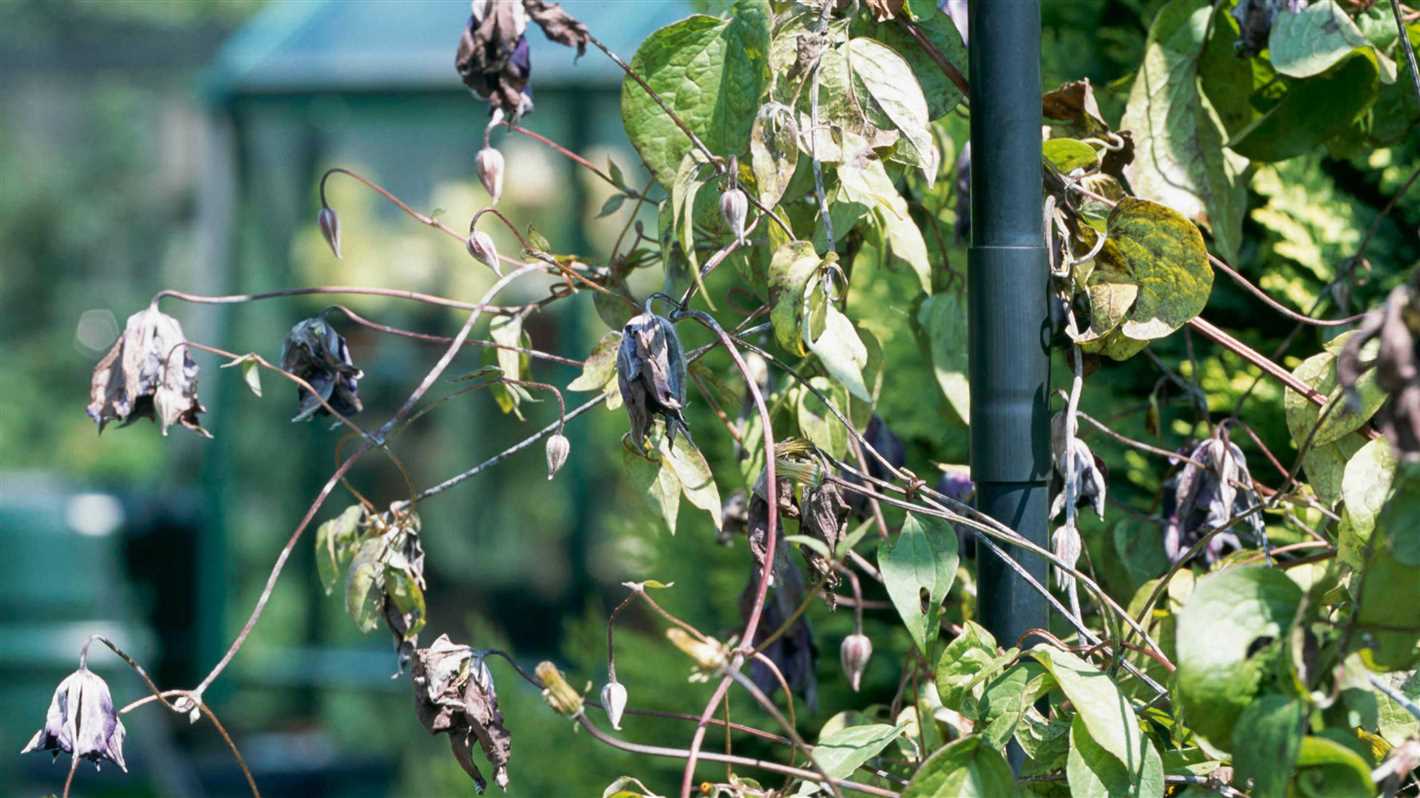
One common problem that gardeners face with their clematis plants is wilting. Wilting can be caused by various factors, but one of the most common causes is improper watering. Both overwatering and underwatering can lead to wilting in clematis plants.
Overwatering
Overwatering is a common mistake that many gardeners make, especially when it comes to clematis plants. When a clematis plant is overwatered, its roots become saturated with water, which can lead to root rot and other fungal diseases. As a result, the plant is unable to take up the necessary nutrients and water from the soil, causing wilting.
To prevent overwatering, it is important to ensure that the soil is well-drained and does not hold excess water. One way to do this is by adding organic matter, such as compost or well-rotted manure, to the soil before planting. Additionally, it is important to water the plants only when the top inch of the soil feels dry to the touch. This will help prevent waterlogged conditions and allow the roots to properly absorb moisture.
Underwatering
On the other hand, underwatering can also result in wilting in clematis plants. When a clematis plant does not receive enough water, its leaves can become limp and wilted. This is because the plant is not able to take up enough water to support its growth and maintain turgidity.
To avoid underwatering, it is important to regularly monitor the moisture levels in the soil. Clematis plants generally prefer moist soil, so it is important to water them deeply and thoroughly. A good rule of thumb is to provide about 1 inch of water per week, either through rainfall or irrigation. However, it is also important to avoid waterlogged conditions, as mentioned earlier, as this can lead to overwatering and root rot.
Conclusion
In conclusion, both overwatering and underwatering can cause wilting in clematis plants. By maintaining a balance in watering and ensuring proper drainage, gardeners can prevent wilting and promote healthy growth in their clematis plants.
Albizia Wilting: Recognizing and Treating Pest Infestations
One of the common causes of albizia wilting is pest infestations. Pests can damage the leaves, stems, and roots of the albizia tree, leading to wilting and eventual death if left untreated. Here, we will discuss how to recognize and treat pest infestations on albizia trees.
Recognizing Pest Infestations
- Wilting leaves: One of the first signs of a pest infestation is the wilting of leaves. If the leaves of your albizia tree are drooping and turning yellow or brown, it may indicate a pest problem.
- Leaf discoloration: Pests can cause discoloration of the leaves. Look for spots, holes, or unusual patterns on the foliage.
- Holes and tunnels: Some pests, such as borers or caterpillars, create holes or tunnels in the trunk or branches of the tree. Check for these signs of infestation.
- Sawdust-like residue: Certain pests produce sawdust-like residue when they burrow into the wood. Look for this residue near the base of the tree or in the bark crevices.
Treating Pest Infestations
If you suspect a pest infestation on your albizia tree, it is important to take action promptly to prevent further damage. Here are some steps you can take to treat pest infestations:
- Identify the pest: It is crucial to identify the pest causing the infestation. This will help determine the most appropriate treatment method.
- Manual removal: For smaller pests, such as caterpillars or beetles, you can manually remove them from the tree by handpicking or spraying them off with water.
- Chemical control: If the infestation is severe, you may need to use chemical insecticides. However, it is important to choose an insecticide that is labeled for use on albizia trees and follow the instructions carefully.
- Pruning: If the infestation has affected specific branches or areas of the tree, you may need to prune them to prevent further spread of the pests.
- Improving tree health: Maintaining the overall health of the albizia tree is important in preventing and treating pest infestations. Ensure proper watering, fertilization, and regular maintenance to keep the tree strong and resilient.
Remember, early detection and prompt action are key in effectively treating pest infestations on albizia trees. Regular monitoring of the tree’s health and implementing appropriate preventative measures can help keep your albizia tree pest-free and thriving.
Wisteria Shattering: Pruning Techniques for a Healthier Plant
Wisteria is a beautiful and popular flowering plant known for its cascading clusters of fragrant flowers. However, one common problem that wisteria plants can face is shattering. Shattering occurs when the plant drops its flowers or unripened pods prematurely. This can be frustrating for gardeners who are looking forward to a spectacular display of blooms.
Causes of Wisteria Shattering
There are several factors that can contribute to wisteria shattering:
- Poor pruning: Wisteria plants require regular and proper pruning to maintain their shape and promote healthy growth. If the plant is not pruned correctly, it can become overcrowded, leading to increased shattering.
- Overfertilization: Applying too much fertilizer or using a fertilizer high in nitrogen can result in excessive vegetative growth at the expense of flower development, causing the plant to shed its flowers prematurely.
- Lack of water: Wisteria plants require a consistent supply of water to thrive. Insufficient watering can stress the plant and cause it to shed its flowers in an attempt to conserve resources.
- Extreme temperatures: Wisteria plants are sensitive to extreme temperatures, especially during the blooming season. Cold snaps or heat waves can cause the flowers and pods to drop prematurely.
Pruning Techniques for Preventing Wisteria Shattering
Proper pruning is essential for maintaining the health and appearance of wisteria plants and minimizing shattering. Here are some pruning techniques to help prevent wisteria shattering:
- Regular pruning: Prune wisteria annually during the dormant season to remove any dead, damaged, or overcrowded branches. This will help improve airflow and light penetration, reducing the risk of shattering.
- Selective pruning: Thin out the overcrowded foliage to allow better air circulation and sunlight exposure. Remove any weak or crossing branches to promote stronger growth and reduce the chances of shattering.
- Pinching off spent flowers: After blooming, pinch off the spent flowers to prevent the plant from wasting energy on developing seeds. This will encourage the plant to redirect its energy towards new flower buds.
- Monitor fertilizer application: Use a balanced fertilizer specifically formulated for flowering plants and follow the recommended application rates. Avoid overfertilization, especially with nitrogen-rich fertilizers, to prevent excessive vegetative growth and potential shattering.
- Maintain consistent watering: Water your wisteria plant regularly, especially during dry periods. Provide enough water to keep the soil moist but not waterlogged. Consistent moisture levels will help prevent stress-induced shattering.
By implementing these pruning techniques and providing proper care, you can help minimize the occurrence of wisteria shattering and enjoy a healthier and more vibrant plant.
Clematis Wilting: Ensuring Proper Sunlight and Shade
The wilting of clematis can occur due to various reasons, but one common factor is improper sunlight and shade conditions. Clematis plants require a good balance of sunlight and shade to thrive and avoid wilting. Here are some factors to consider when ensuring proper sunlight and shade for your clematis:
1. Sunlight Requirements
Clematis plants prefer a sunny location, but they also need protection from intense afternoon sun. The ideal location is where they receive at least 6 hours of sunlight, preferably in the morning or evening.
To provide the right amount of sunlight, you can:
- Plant clematis near a wall or tall shrubs that can provide some shade in the afternoon but allow morning sun to reach the plant.
- Use garden structures like trellises or arbors to provide some shade during the hottest part of the day.
- Choose the right variety of clematis that can tolerate more or less sunlight based on your specific conditions.
2. Shade Requirements
While clematis plants need sunlight, they also require some shade to protect them from extreme heat. Excessive exposure to sunlight can lead to wilted leaves and dried out plants.
To provide adequate shade for your clematis, you can:
- Plant companion plants with large leaves or structures that can create dappled shade.
- Use mulch around the base of the plant to keep the roots cool and protected from direct sunlight.
- Place potted clematis in areas where they can receive partial shade during the hottest part of the day.
Remember to regularly monitor the sunlight and shade conditions for your clematis plants, as they can change over time due to growth or changes in the environment. By ensuring the right balance of sunlight and shade, you can help prevent wilting and promote healthy growth in your clematis.
Questions and Answers:
Why is my clematis wilting?
Your clematis may be wilting due to a lack of water, insufficient sunlight, or a fungal disease. Make sure to water your clematis regularly, provide it with adequate sunlight, and monitor it for signs of disease.
What should I do if my albizzia is wilting?
If your albizzia is wilting, it could be due to overwatering, underwatering, or a root issue. Check the soil moisture levels and adjust your watering accordingly. Also, inspect the roots for any signs of damage or disease. If necessary, replant the albizzia in well-draining soil.
Why is my wisteria shattering?
Wisteria shattering can occur due to several reasons, including improper pruning, high winds, and weak branches. Ensure that you are pruning your wisteria correctly, providing support to the branches in windy conditions, and inspecting the plant for any signs of weak or damaged branches.
How often should I water my clematis?
The frequency of watering your clematis will depend on several factors, including the climate, soil type, and overall health of the plant. Generally, clematis plants require regular watering, especially during hot and dry periods. Water deeply and thoroughly, ensuring that the soil is moist but not waterlogged.
Can fungal diseases affect my clematis?
Yes, fungal diseases can affect clematis plants. One common fungal disease that can cause wilting is clematis wilt. This disease is caused by the fungus Phoma clematidina, which attacks the stem and leaves of the plant. To prevent or treat fungal diseases, ensure good air circulation around the plant, avoid overwatering, and consider using fungicides if necessary.







